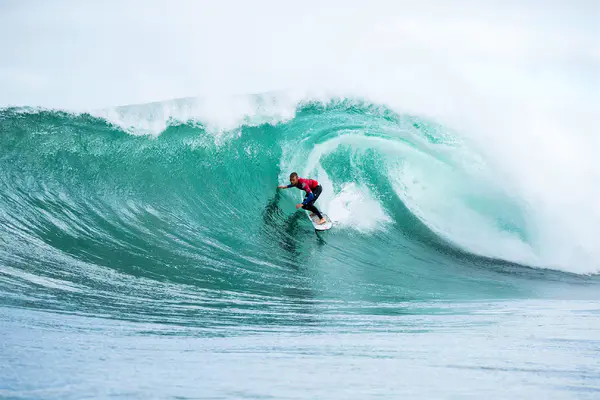Surfing is a popular water sport. It involves riding on the forward part of a wave. Surfing provides a great workout. This article explores the muscles worked by surfing. We’ll look at the main muscle groups involved. You’ll also learn how surfing benefits your body.
Upper Body Muscles
Shoulders and Back Muscles
Surfing works your shoulders a lot. Paddling engages the deltoid muscles. These are the muscles at the top of your shoulders. Paddling helps you move through the water. Strong shoulders are important for surfing. They give you the power to catch waves.
Your back muscles play a big role in surfing. The latissimus dorsi, or lats, are key. These are the large muscles on the sides of your back. Paddling uses these muscles a lot. They help you pull your arms through the water. Strong lats give you better control and power.
Arms and Chest
Surfing works your arm muscles too. The biceps and triceps are both important. Paddling uses your biceps to pull your arms. The triceps are used when you push up to stand on the board. Strong arms help you paddle faster and catch more waves.
The chest muscles, or pectorals, are used in surfing. Paddling engages these muscles. The pectorals help you pull your arms through the water. They also help when you push up to stand on the board. Strong chest muscles give you more power and stability.
Core Muscles
Abdominals
Surfing works your abdominal muscles a lot. The rectus abdominis, or “six-pack” muscles, are key. These muscles help you stay balanced on the board. They also help you twist and turn. Strong abs give you better control and stability.
Obliques
The obliques are the muscles on the sides of your abdomen. Surfing engages these muscles too. The obliques help you twist and turn your body. This is important for maneuvering on the board. Strong obliques give you better control and power.
Lower Back
The lower back muscles are also important for surfing. The erector spinae muscles help you stay balanced. They also help you arch your back when paddling. Strong lower back muscles give you better stability and control.
Lower Body Muscles
Surfing works your leg muscles a lot. The quadriceps, hamstrings, and calves are all important. The quadriceps are the muscles on the front of your thighs. They help you stand up on the board. The hamstrings are the muscles on the back of your thighs. They help you stay balanced. The calves are the muscles on the back of your lower legs. They help you stay on the board and control your movements. Strong legs give you better stability and power.
The gluteal muscles, or glutes, are the muscles in your buttocks. Surfing engages these muscles too. The glutes help you stay balanced on the board. They also help you control your movements. Strong glutes give you better stability and power.
Cardiovascular Benefits
Surfing is a great cardiovascular workout. Paddling helps improve your endurance. It keeps your heart rate up. This improves your cardiovascular health. Better endurance means you can surf for longer periods.
Surfing burns a lot of calories. Paddling, standing, and maneuvering all burn calories. This helps you maintain a healthy weight. It also improves your overall fitness.
See Also: Which Beach Has Water Sports in Goa?
Balance and Stability
Core Strength
Surfing improves your balance and stability. Your core muscles are key for this. Strong core muscles help you stay balanced on the board. They also help you control your movements. Better balance and stability make you a better surfer.
Coordination
Surfing also improves your coordination. You need to coordinate your movements to stay on the board. This helps improve your overall coordination. Better coordination makes you a better surfer.
Mental Benefits
- Stress Relief:Surfing is good for your mental health too. Being in the water is relaxing. Surfing helps reduce stress. It also improves your mood. This makes you feel better overall.
- Focus:Surfing requires focus. You need to concentrate on your movements. This helps improve your focus and concentration. Better focus makes you a better surfer.
Conclusion
Surfing is a great workout. It works many muscle groups in your body. Your upper body, core, and lower body muscles are all engaged. Surfing also provides cardiovascular benefits. It improves your balance, stability, and coordination. Plus, it has mental health benefits. Surfing is a fun and effective way to stay fit and healthy.
FAQ: What Muscles Does Surfing Work
Q: What muscles are primarily used in surfing?
A: Surfing primarily uses core, upper body, and leg muscles.
Q: How does surfing engage the core muscles?
A: Surfing engages the core muscles for balance and stability on the board.
Q: Which upper body muscles are involved in paddling?
A: Paddling uses the shoulders, back, and arm muscles.
Q: What role do the legs play in surfing?
A: Legs provide power for popping up and maintaining stance.
Q: Are there specific leg muscles that surfing targets?
A: Yes, surfing targets the quadriceps, hamstrings, and calves.
Q: Does surfing work the glute muscles?
A: Yes, surfing engages the glutes for stability and movement.
Q: How do the chest muscles contribute to surfing?
A: The chest muscles help with paddling and popping up on the board.
Q: Does surfing involve the lower back muscles?
A: Yes, the lower back muscles are crucial for maintaining posture and balance.
Q: Can surfing improve overall muscle strength?
A: Yes, surfing improves overall muscle strength and endurance.
Q: Is surfing a good full-body workout?
A: Absolutely, surfing is an excellent full-body workout.

